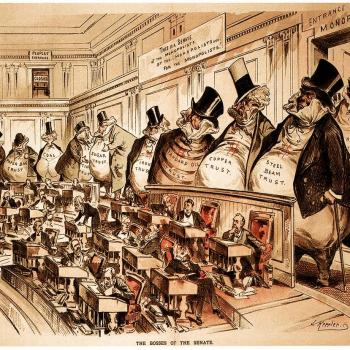The New American Evangelical Liturgy
Over the years I have had the blessing and curse of visiting numerous (very broadly defined) evangelical Christian churches in the United States. I have spoken in many and simply visited many unnoticed. They were of many different denominations spanning the entire spectrum of historic, classical evangelicalism: Pentecostal, fundamentalist, “Third Wave,” conservative Presbyterian, Reformed, Adventist, Lutheran, Wesleyan, independent, etc.
One thing I have noticed especially in recent years is a convergence of worship styles. No matter what the denominations, evangelical churches tend to worship in almost exactly the same way—especially in larger cities.
In recent years I have had the joy and curse of visiting about ten or twelve evangelical churches in a particular major American city. They are of very different denominations and traditions.
I realize that I am generalizing here, but I believe my generalization of the situation is valid as to a trend in worship. In a general way, with some minor differences, most metropolitan evangelical churches in the U.S. are worshiping the same way. I call it the “new evangelical liturgy.”
*Sidebar: The opinions expressed here are my own (or those of the guest writer); I do not speak for any other person, group or organization; nor do I imply that the opinions expressed here reflect those of any other person, group or organization unless I say so specifically. Before commenting read the entire post and the “Note to commenters” at its end.*
Now, please, please don’t post a comment here saying “Well my church doesn’t worship like that.” I know there are exceptions. I’m talking here about a noticeable trend. And my belief in it is not based solely on my experiences visiting churches. I have consulted scholars who have written books about worship and who teach about worship and who have their “finger on the pulse” of American worship trends. They confirm what I am saying here.
In a matter of one year recently (very recently) I visited about ten or twelve broadly defined evangelical churches in a large portion of a large American metroplex (city with numerous suburbs). I also examined at least twenty-five web sites of broadly defined evangelical churches in the same metroplex in order to confirm or disconfirm what I experienced in the approximately twelve I visited on Sunday mornings.
Here is the new evangelical liturgy: The worship service begins with loud music either recorded or sung by a “worship team” led by a “music minister.” Then there is a “welcome” and sometimes encouragement to greet each other (in the congregation). Then there follows a long series of contemporary Christian songs with no discernable tunes sung mostly by the worship team. The words are projected onto one or more large screens. There are no hymnbooks in sight or, if they are there, they are not touched. The songs tend to be repetitious and have little or no theological content or biblical imagery. One could not be blamed for assuming they were written for performance, not congregational singing. About a third of the congregation attempts to sing the songs with the worship team. Hardly anyone over fifty even attempts to sing them.
Then (somewhere in the order of worship) comes the seemingly obligatory “old hymn” but often sung to a different tune than found in any hymn book. By “obligatory” I mean—sung only so that people over fifty will feel like there was “something for them” in the worship service. This is the new “blended worship.” The obligatory hymn (usually something like Great Is They Faithfulness or Amazing Grace or On Christ the Solid Rock I Stand) is sung with “gusto” by the older folks (everyone over fifty) and sometimes with some enthusiasm by the younger folks. The level of congregational participation ramps up very much during the singing of the hymn. Then back to a vocalist (usually one of the worship team) steps forward and sings a song not in any hymnbook and the worship leader “invites” the congregation to join in on part of it. Often the “vibe” of the music portion of the service is that of a rock concert.
Then, following the music, which lasts about thirty minutes during which everyone stands (except the old people who can’t stand that long and I am one of them), the congregation sits down and listens to a twenty-to-thirty minute “talk” by a minister-pastor. Rarely is it expository; it is almost always topical and thematic and sounds like good advice. The content is aimed at people who know very little about the Bible or Christianity. Words like “regeneration” or “justification” or “atonement” are rarely heard in such popular preaching anymore.
During the sermon, especially younger people in the congregation often look at their cell phones, sip coffee they got out on the foyer during the musical portion of the worship.
Then, at the end of the inspiration talk (sermon) the congregation stands and the worship team sings another song obviously unfamiliar to everyone in the congregation over fifty and obviously unsingable by even most of the younger people and then the dismissal and encouragement to grab some coffee and bagel in the foyer and chat.
So what’s missing in this new evangelical liturgy—compared with more traditional evangelical worship?
First, there is no formal reading of Scripture. The pastor may or may not use some scripture. Second, there is often no formal praying for the needs of the people and the world or for anything. Third, there is no repetition of the Lord’s Prayer or any creed or confession of faith or even a doxology. In all, there is very little, if any, participation by the congregants other than singing by those who can. Many can’t simply because the songs are new and have no tune to learn and were probably written for performance, not congregational singing.
Fourth, there is usually no hint of conviction or need for confession, repentance or pardon on the part of the people gathered. Fifth, there is usually no hint of doctrine and no biblical imagery or “language of Zion” (traditional Christian words and phrases that might not be known to people new to church). Sixth, there is usually no hint of “prophetic speech” about politics (broadly defined), cultural decline or social problems. The inspirational talk is almost always aimed at therapy—applying to “gospel” to individual lives to help them live with and hopefully overcome their life challenges.
The main thing I find missing in this new evangelical liturgy is authenticity. I have made a point of asking numerous scholars or worship, pastors (both older and younger), worship leaders (almost always youngish) and others “in the know” about contemporary worship trends. I have asked my students. Almost all agree that what is going on in this paradigm shift to the new evangelical liturgy is a desperate attempt to draw in and keep young people—meaning people from about age 40 down to teens.
I recently contacted a Christian scholar of worship, a worship theologian who notably has his finger on the pulse of American trends in worship and has followed trends for many years and written books about the subject. I asked him “Who won the worship wars?” (of the 1980s and 1990s and beyond) His answer was what I think, too: the contemporary side. Traditional worship is almost entirely dead except in churches that are dying.
Now, contemporary worship is fine so long as it is authentic and not a pathetic attempt to attract and keep people by means of entertainment and a truncated gospel. The problem is that the new evangelical liturgy leaves out a lot of authentic Christian congregational worship. There is very little concern to include the congregation; almost everything is “going on” on the “platform” with the congregation watching and listening. Take away the “sermon” (inspirational talk) and what happens is almost exactly what happens at a Christian rock concert. (Yes, I have attended them—from Petra to Tree63 to Casting Crowns!) In fact, one of my only claims to fame is my one time close association with Petra. I was the organizer of one of the group’s earliest concerts. They asked to perform at a Youth for Christ event that I was in charge of and they took a free will offering. They were almost completely unknown then.
How a church should worship is clearly dictated in the New Testament. In 1 Corinthians (14:26) the Apostle Paul says that when Christians come together “each one” should have something to contribute. I take that to mean congregational participation. It may not be possible in today’s larger churches for literally “each one” in the congregation to contribute something distinct to the worship service, but to leave congregational participation aside entirely, to care nothing about it, to put on a display of musical talent without inviting the whole congregation to participate (other than watch and listen) and make that possible is unbiblical. I’m not saying that the new evangelical liturgy intentionally does that; I’m saying it unintentionally does that and that is wrong. Pastors and worship leaders need to work hard at making congregational participation not only possible but likely. The new evangelical liturgy has minimized the “space” for congregational participation almost to the vanishing point. And one can tell just by looking around and listening during most Sunday morning evangelical worship services. Most of the people are not doing anything but watching and listening, possibly being inspired (or entertained), and some looking at their smart phones or tablets.
*Note to commenters: This blog is not a discussion board; please respond with a question or comment only to me. If you do not share my evangelical Christian perspective (very broadly defined), feel free to ask a question for clarification, but know that this is not a space for debating incommensurate perspectives/worldviews. In any case, know that there is no guarantee that your question or comment will be posted by the moderator or answered by the writer. If you hope for your question or comment to appear here and be answered or responded to, make sure it is civil, respectful, and “on topic.” Do not comment if you have not read the entire post and do not misrepresent what it says. Keep any comment (including questions) to minimal length; do not post essays, sermons or testimonies here. Do not post links to internet sites here. This is a space for expressions of the blogger’s (or guest writers’) opinions and constructive dialogue among evangelical Christians (very broadly defined).

















